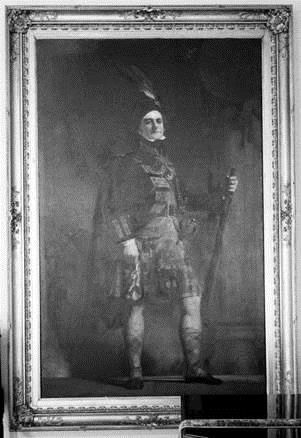
Best viewed in
Internet Explorer
Music (PDF)
Music (BMW)
Back to

Updated
05/09/2016 |

Arndblair
Castle
|
Ardblair Castle is a fine
example of a courtyard castle, and probably dates from the late
16th century. The present castle stands on a ridge of high
ground rising from the Moss of Ardblair, and replaced an earlier
castle which itself was built on the site of an old fort.
When the
first castle was built, possibly in the thirteenth century, the
rocky outcrop on which it stood was a promontory jutting out
into a loch, so that the castle was surrounded on three sides by
water. At the base of the current castle some of the bedrock can
be seen at the north-west corner.
 |
Who built the castle is unclear, although old charters
show that a Stephani de Blare, or Stephen de Blair,
owned land in the parish of Blair in Gowrie (ie the
parish of Blairgowrie) in the late 12th century. He is
recorded as having granted the lands of Lethcassy (now
Carsie) to the monks of Coupar Angus abbey sometime
between 1191 and 1198. Carsie is a neighboring property
to Ardblair, so it is tempting to speculate that Stephen
(or one of his ancestors) was responsible for building
the first castle.
Ardblair is specifically mentioned in 1399, when it was
granted to Thomas Blair of
Balthayock
during the reign
of Robert III. At that time the Ardblair estate was
extensive, making up one fifth of the parish of
Blairgowrie. He has been described as the first Blair of
Ardblair, however it does seem that the Blairs possessed
Ardblair prior to him.
The original castle is said to have stood at the
north-west corner of the current courtyard, where the
later castle now stands. At some point in the late 16th
century an L-plan tower house was built on the footings
of the old castle. Rising to a height of three stories
plus an attic, the ground floor is vaulted and
originally consisted of store rooms. |
|
In the 17th century the castle
was evidently extended, with the addition of a low wing
projecting east from the lesser wing. At the east end of this
new building is a further range of offices extending north,
forming three sides of a courtyard. A wall connects the old and
the new parts of the castle on the north side, and an arched
gateway gives access to the courtyard within. Above the arch, on
top of the wall, is a carved pediment with coat of arms carrying
the date 1668.
The male line of the Blairs of
Ardblair failed in 1770 upon the death of James Blair, who left
two daughters, Margaret and Rachel. Margaret succeeded her
father, but died childless in 1802 and Ardblair passed to
Rachelís daughter, Christian Robertson. In 1795 Christian
married Laurence Oliphant, 8th of Gask, and their second son was
given the name James Blair Oliphant, succeeding to Ardblair in
1829.
Ardblair
Castle is still owned by the Blair Oliphant family, and is the
seat of Oliphant of Gask. |
|
 |
|



